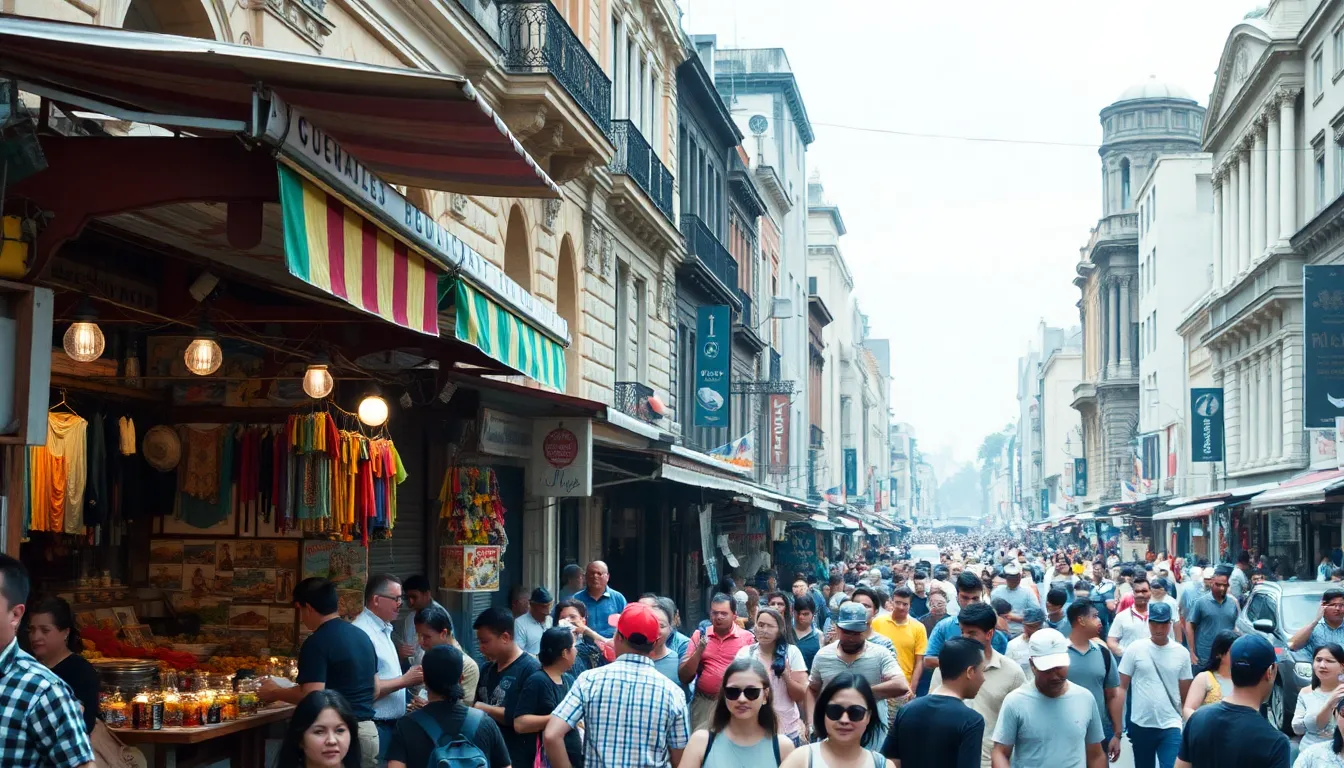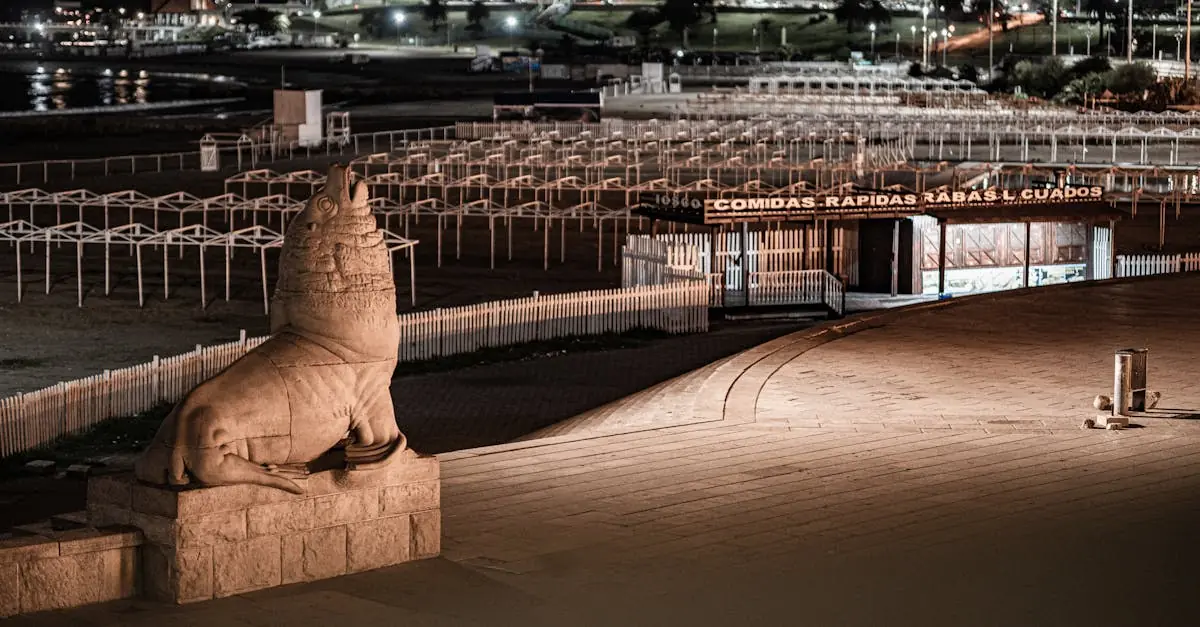In 2024, Mexico City is set to hit a staggering population milestone that’ll make you question if it’s a city or a bustling ant colony. With over 9 million residents packed into this vibrant metropolis, the energy is palpable, and the taco stands are never empty. This urban jungle, known for its rich history and diverse culture, is a place where every corner has a story, and every street has its own flavor.
As the population continues to grow, so do the challenges and opportunities that come with it. From navigating traffic that feels like an extreme sport to discovering hidden gems in the city’s nooks, living in Mexico City is an adventure like no other. Buckle up as we dive into the fascinating dynamics of this ever-evolving urban landscape and explore what the future holds for its ever-increasing population.
Table of Contents
ToggleOverview of Mexico City
Mexico City stands as one of the largest urban centers globally. It houses over 9 million residents as of 2024, showcasing a dynamic blend of cultures. Visitors often marvel at its historic architecture alongside modern developments. Navigating the city can be challenging due to heavy traffic and population density.
Rich in history, Mexico City features sites like the Zócalo, the largest plaza in Latin America, and Templo Mayor, a significant Aztec ruin. Diverse neighborhoods each offer distinct experiences, from the artsy vibe of Coyoacán to the bustling markets of La Merced. Culinary delights abound with street food experiences serving tacos and tamales.
Immersing in the city’s energy reveals a vibrant cultural scene, including world-class museums such as the Museo del Palacio de Bellas Artes. Festivals and events occur year-round, celebrating everything from traditional dances to modern music. Parks and plazas provide residents a respite from urban life, with places like Chapultepec Park featuring lakes and museums.
Addressing rapid population growth presents significant challenges. Resources become constrained, leading to discussions about infrastructure improvements and public services. Opportunities arise in urban planning, focusing on sustainability and enhancing quality of life. Authors and researchers explore these dynamics, highlighting innovative solutions for a bustling metropolis.
Understanding the intricacies of Mexico City’s growth and character proves essential for grasping its future trajectory. The evolving urban landscape reflects not only its history but also the ambitions of its people. With each passing year, this vibrant city continues to shape itself, embracing both its past and future.
Current Population Statistics

In 2024, Mexico City’s population is anticipated to surpass 9 million residents, underscoring its standing as a vibrant urban center.
Total Population in 2024
The projected total population of Mexico City for 2024 reaches approximately 9.2 million residents. This figure signifies continued urban growth as people migrate from rural areas and other regions seeking better opportunities. Its density remains notable, with significant variations across different neighborhoods. Areas like Iztapalapa and Gustavo A. Madero showcase considerable concentrations of residents, reflecting the city’s diverse living scenarios.
Population Growth Trends
Population growth in Mexico City has shown a steady increase over the past decade. Each year presents approximately a 1% growth rate, driven primarily by internal migration and natural population increases. Such trends highlight the city’s role as a leading employment hub, attracting individuals from various states. Urban planning initiatives respond to these dynamics, focusing on sustainable growth and adequate public services. Strikingly, residents increasingly prioritize access to housing, transit, and amenities, shaping future developments throughout the metropolis.
Demographic Breakdown
Demographic data for Mexico City in 2024 paints a detailed picture of its residents. Understanding age distribution and gender ratio helps grasp the city’s social dynamics.
Age Distribution
In 2024, approximately 28% of residents in Mexico City fall into the age group of 0 to 14 years, highlighting a youthful foundation. The working-age population, comprising ages 15 to 64 years, constitutes about 65%, reflecting a robust labor force. Seniors aged 65 and over make up approximately 7%, indicating a growing focus on elderly services. Investments in education and employment opportunities will cater to this diverse age range, ensuring a skilled workforce. Moreover, these dynamics influence housing, healthcare, and recreational planning throughout the metropolis.
Gender Ratio
The gender ratio in Mexico City is relatively balanced, with approximately 51% of the population identifying as female and 49% as male. This balance reveals a demographic stability that fosters social cohesion. Women often take on significant roles in the workforce and local governance, shaping community initiatives. Gender-based programs target challenges impacting specific groups, such as violence against women and educational disparities. Addressing these issues remains vital for enhancing the quality of life and promoting equality as the population continues to grow.
Factors Influencing Population Change
Population change in Mexico City results from various interconnected factors. Migration and demographic trends play crucial roles in shaping the city’s future landscape.
Migration Patterns
Migration significantly impacts the population dynamics of Mexico City. Individuals from rural areas and other provinces arrive in search of better job opportunities and educational resources. Statistics reveal that migration accounts for a notable portion of demographic changes, with many young adults moving to urban centers. These newcomers contribute to the cultural diversity and vibrancy of the city. Seasonal migration also occurs, as families temporarily relocate for agricultural work or tourism-related activities. The accessibility of transportation and amenities further influences the flow of migrants, leading to increased urbanization.
Birth and Death Rates
Birth and death rates contribute essential insights into Mexico City’s population structure. The current birth rate stands at approximately 14.3 births per 1,000 people. This figure reflects a gradual decline in fertility rates, highlighting shifting societal norms. Death rates, on the other hand, hover around 5.7 deaths per 1,000 individuals. A balanced ratio indicates a growing population, yet increasing life expectancy leads to a higher proportion of elderly residents. These demographic shifts necessitate a re-evaluation of healthcare services and infrastructure to address the needs of a diverse age group. Understanding these rates aids in accurate projections, making it vital for urban planning and public services.
Comparison with Previous Years
Mexico City’s population has seen a steady increase over the last decade, reflecting ongoing urban growth. In 2014, the population stood at approximately 8.9 million, marking a significant baseline for comparison. By 2019, it had risen to around 9.1 million, showcasing a consistent trend of migration and urbanization.
Projected figures for 2024 suggest the population will reach approximately 9.2 million. Such growth emphasizes the importance of understanding both migration patterns and demographic shifts. Migration from rural areas and smaller cities accounts for a large part of this increase, as many seek enhanced opportunities in the capital.
In addition to migration, birth and death rates contribute to population changes. The current birth rate is about 14.3 per 1,000 people, while the death rate stands at around 5.7 per 1,000 individuals. These statistics highlight shifts in societal norms and improvements in healthcare, leading to longer life expectancy. The city’s demographic composition is vital for urban planning and public service allocation.
Examining demographic breakdowns reveals that about 28% of residents are aged 0 to 14 years. Working-age individuals, aged 15 to 64 years, constitute approximately 65% of the population. Seniors, aged 65 and over, make up around 7%, indicating a growing emphasis on elderly services. Gender dynamics remain relatively balanced, with near equal representation of females and males.
Understanding these figures is crucial for effective resource management, infrastructure development, and community services. As Mexico City’s population grows, addressing the accompanying challenges becomes increasingly vital for maintaining its vibrant cultural landscape and ensuring a high quality of life for all residents.
Future Projections
Projected population growth in Mexico City suggests it may reach approximately 9.2 million residents by 2024. Migration from rural areas continues to play a significant role, bringing in individuals seeking enhanced opportunities. Age distribution will show around 28% of the population ages 0 to 14 years, while the working-age group, those between 15 to 64 years, comprises about 65%. Seniors aged 65 and older are expected to account for approximately 7%. Balancing this demographic will require a focus on elderly services.
Forecasts indicate a stable gender ratio, with an estimated 51% female and 49% male. Women increasingly contribute to the workforce and governance, influencing overall social dynamics. Support programs targeting issues like gender-based violence and educational equity are essential moving forward.
Current birth and death rates are also anticipated to remain steady. The birth rate at approximately 14.3 births per 1,000 individuals and the death rate around 5.7 deaths per 1,000 indicate a clear challenge for healthcare planning. Increasing life expectancy alongside these rates necessitates constant evaluation of services.
Historically, the population has steadily increased, rising from about 8.9 million in 2014 to nearly 9.1 million in 2019. Such trends in migration and urbanization require a focused approach to urban planning. Amid this growth, identifying innovative solutions becomes critical for sustainability and improving the quality of life for diverse residents.
As Mexico City approaches a population of over 9 million in 2024 it stands at a pivotal moment in its history. This growth not only reflects the city’s allure but also its challenges. The balance between preserving cultural heritage and accommodating an ever-increasing population will require innovative urban planning and sustainable practices.
The demographic shifts underscore the need for targeted services especially for the youth and the elderly. With a diverse population comes the opportunity to enrich the city’s cultural tapestry while addressing the pressing issues of infrastructure and public services. Mexico City’s future hinges on its ability to adapt and thrive amidst these changes ensuring a vibrant and inclusive environment for all its residents.







